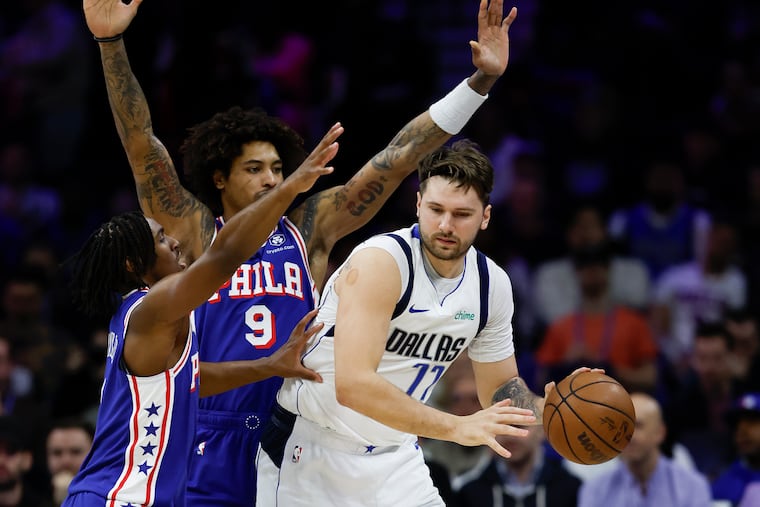Mavericks have proved Daryl Morey’s point about continuity ... with one big exception
The Mavericks have accomplished what the Sixers are setting out to do this offseason.

A month ago, Daryl Morey spent part of his end-of-season press conference railing against the notion that there existed some magic formula for building a championship contender. Among the themes he zeroed in on was continuity, a pertinent topic given that the Sixers were heading into the offseason with Joel Embiid and Tyrese Maxey as the only rotation players signed to guaranteed contracts (and Maxey technically hasn’t even signed yet).
The previous week, Embiid had bemoaned the yearly roster turnover he’d experienced during his career with the Sixers. He rattled off a number of examples of teams that had won titles after years of playing together. The Warriors, the Nuggets, and the Bucks all offered some evidence of the foolishness of attempting to build a championship-caliber roster in a single offseason.
Morey didn’t see it that way.
“We’re not going to have continuity,” said the Sixers president and chief personnel decision-maker. “Hopefully, we’ll have continuity going forward a little better. We’ll have continuity with our stars and our head coach. But we’re going to have a lot of change this offseason. ... Long story short, there isn’t a formula. Everyone wants to find a pattern and there isn’t one. The pattern is have really good players and have them [be] better than all the teams you’re going to play. We’re not going in with a prescription or proscription of what to do.”
It was a curious hill for Morey to defend. While his overarching point was sound — the sample size of title winners is far too limited and context-dependent to derive any sort of universal truths about roster-building strategies — continuity has clearly played an important role in all sorts of successful franchises. When you think of the great Spurs teams, you see Tim Duncan, Tony Parker, and Manu Ginóbili. When you think of the great Warriors teams, you think of Steph Curry, Klay Thompson, and Draymond Green (don’t @ me, K.D.). Present-day contenders like the Nuggets, Thunder, and Timberwolves have all taken more of an organic team-building approach than treating the offseason as an annual big-game hunt.
And then we have the Mavericks.
At the time Morey spoke, nobody gave Dallas much of a chance of proving his point. But, here the Mavericks are, waltzing into the NBA Finals with a roster that was assembled in much the same manner the Sixers will be looking to operate this offseason. Of their top eight rotation players in the Western Conference finals against Minnesota, only superstar Luka Dončić and reserve guard Josh Green had been with the team for more than two seasons. Four of those rotation players are in their first year in Dallas, including two starters who were picked up at midseason.
» READ MORE: The Joel Embiid conundrum will take center stage this offseason
Of any team to appear in the NBA Finals in recent years, the Mavericks are the one that has followed a similar path to the Sixers. That is, a meandering, exhausting and, at times, treacherous path. Dončić’s first five years in the NBA saw him playing alongside a rotating and often poorly fit cast of characters that included Harrison Barnes, Kristaps Porziņģis, Christian Wood, and Spencer Dinwiddie. The one who proved to be the best, Jalen Brunson, was the one they let go. By the time the Mavericks acquired Kyrie Irving midway through last season, the move was viewed more or less as a Hail Mary by a team that seemed out of options.
The comp isn’t perfect. As Morey noted, there are no perfect comps. Dallas has several reserves who have been with the team for three-plus years — Green (four), Maxi Kleber (seven), Dwight Powell (10) — plus injured sixth man Tim Hardaway Jr. Brunson spent four years playing alongside Dončić.
That said, the Mavericks certainly offer an argument against the necessity of continuity. Irving and Dončić will enter the NBA Finals having played 84 games together in their careers. The Mavericks acquired their third-leading scorer, forward P.J. Washington, at this year’s trade deadline. Same goes for center Daniel Gafford. They drafted big man Dereck Lively II last June and signed wing Derrick Jones Jr. last offseason.
Frankly, it’s the kind of roster maneuvering the Sixers should have in mind this offseason. In Morey’s end-of-season press conference, he sounded like a man laying out the case for the pursuit of a third superstar to put alongside Embiid and Maxey. That said, Morey was simply responding to the questions he was asked, many of which were (tacitly) focused on the looming free agencies of stars Paul George and LeBron James, plus the potential trade availability of Jimmy Butler. His central premise, which he has repeated often, is that the best teams are the ones with the best players. The more, the merrier.
But Morey also said something that shouldn’t be overlooked, by us or his front office.
“We’re definitely looking at fit,” the Sixers’ prez said at the time. “We’re not really focused, necessarily, on the exact bucket, whether it’s max, role player, or whatever.”
The Mavericks aren’t just evidence that a team can accomplish what the Sixers are setting out to do. They are evidence that Morey doesn’t necessarily need another superstar to accomplish it.
Of course, a lot depends on how you view Embiid and Maxey — can they do what Dončić and Irving have done this postseason? Or does Embiid’s frequent unavailability leave the Sixers with a greater need for a player who can carry a primary scoring load alongside Maxey?
Big questions for a big offseason.